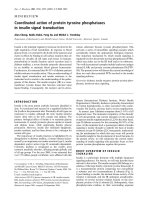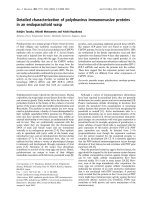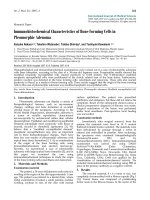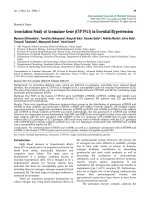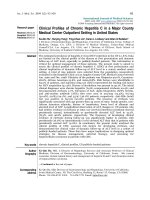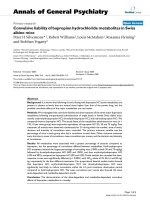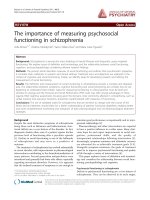Báo cáo y học: " Short-term outcomes of cadaveric lung transplantation in ventilator-dependent patient" pptx
Bạn đang xem bản rút gọn của tài liệu. Xem và tải ngay bản đầy đủ của tài liệu tại đây (180.47 KB, 7 trang )
Open Access
Available online />Page 1 of 7
(page number not for citation purposes)
Vol 13 No 4
Research
Short-term outcomes of cadaveric lung transplantation in
ventilator-dependent patients
Hsao-Hsun Hsu
1
, Jin-Shing Chen
1
, Wen-Je Ko
1,2
, Shu-Chien Huang
1
, Shuenn-Wen Kuo
1,2
, Pei-
Ming Huang
1
, Nai-Hsin Chi
1
, Chin-Chih Chang
1,2
, Robert J Chen
3
and Yung-Chie Lee
1
1
Department of Surgery, National Taiwan University Hospital and National Taiwan University College of Medicine, No. 7, Chung-Shan South Road,
Taipei City, 100, Taiwan
2
Department of Traumatology, National Taiwan University Hospital and National Taiwan University College of Medicine, No. 7, Chung-Shan South
Road, Taipei City, 100, Taiwan
3
Institute of Epidemiology, College of Medicine, National Taiwan University, No. 1, Section 1, Ren-Ai Road, Taipei City, 100, Taiwan
Corresponding author: Yung-Chie Lee,
Received: 27 Mar 2009 Revisions requested: 17 Apr 2009 Revisions received: 3 Aug 2009 Accepted: 6 Aug 2009 Published: 6 Aug 2009
Critical Care 2009, 13:R129 (doi:10.1186/cc7989)
This article is online at: />© 2009 Hsu et al.; licensee BioMed Central Ltd.
This is an open access article distributed under the terms of the Creative Commons Attribution License ( />),
which permits unrestricted use, distribution, and reproduction in any medium, provided the original work is properly cited.
Abstract
Introduction Survival after cadaveric lung transplantation (LTx)
in respiratory failure recipients who were already dependent on
ventilation support prior to transplantation is poor, with a
relatively high rate of surgical mortality and morbidity. In this
study, we sought to describe the short-term outcomes of
bilateral sequential LTx (BSLTx) under extracorporeal membrane
oxygenation (ECMO) support in a consecutive series of
preoperative respiratory failure patients.
Methods Between July 2006 and July 2008, we performed
BSLTx under venoarterious (VA) ECMO support in 10
respiratory failure patients with various lung diseases. Prior to
transplantation, 6 patients depended on invasive mechanical
ventilation support and the others (40%) needed noninvasive
positive pressure ventilation to maintain adequate gas
exchange. Their mean age was 40.9 years and the mean
observation period was 16.4 months.
Results Except for 1 ECMO circuit that had been set up in the
intensive care unit for pulmonary crisis 5 days prior to
transplantation, most ECMO (90%) circuits were set up in the
operating theater prior to pneumonectomy of native lung during
transplantation. Patients were successfully weaned off ECMO
circuits immediately after transplantation in 8 cases, and within
1 day (1/10 patients) and after 9 days (1/10 patients) due to
severe reperfusion lung edema following transplantation. The
mean duration of ECMO support in those successfully weaned
off in the operating theater (n = 8) was 7.8 hours. The average
duration of intensive care unit stay (n = 10) was 43.1 days
(range, 35 to 162 days) and hospital stay (n = 10) was 70 days
(range, 20 to 86 days). Although 4 patients (40%) had different
degrees of complicated postoperative courses unrelated to
ECMO, all patients were discharged home postoperatively. The
mean forced vital capacity and the forced expiratory volume in 1
second both increased significantly postoperatively. The
cumulative survival rates at 3 months and at 12 months post-
transplantation were 100% and 90%.
Conclusions Although BSLTx in this critical population has
varied surgical complications and prolonged length of
postoperative ICU and hospital stays, all the patients observed
in this study could tolerate the transplant procedures under VA
ECMO support with promising pulmonary function and
satisfactory short-term outcome.
Introduction
Lung transplantation (LTx) has been performed internationally
as a viable, life-saving intervention for a variety of end-stage
lung diseases. However, ventilator dependency while on the
waiting list is still considered to be a relative or absolute con-
traindication to LTx by most centers, because of concerns
regarding the possible risk of post-transplant pneumonia and
relatively high one-year mortality rates [1,2]. Moreover, the
BSLTx: bilateral sequential lung transplantation; CPB: cardiopulmonary bypass; CxR: chest x-ray; ECMO: extracorporeal membrane oxygenation;
FEV
1
: forced expiratory volume in one second; FiO
2
: fraction of inspired oxygen; FVC: forced vital capacity; LTx: lung transplantation; NIPPV: nonin-
vasive positive pressure ventilation; PEEP: positive end-expiratory pressure; PaCO
2
: partial pressure of arterial carbon dioxide; PaO
2
: partial pressure
of arterial oxygen; RML: right middle lobe; VA: venoarterious.
Critical Care Vol 13 No 4 Hsu et al.
Page 2 of 7
(page number not for citation purposes)
long-term immobility and bed stay predispose this population
to severe deconditioning before LTx, increase postoperative
complications, and delay recovery after LTx [3,4].
The distribution of donor lungs in Taiwan is based on both
accumulated waiting time and medical urgency (risk of death
without a transplant). In addition, the latter criterion was given
priority over the former. Waiting list patients already depend-
ent on invasive or noninvasive mechanical ventilator support
are defined as 'respiratory failure' and are placed in 'status I'
waitlists, whom are given first priority to obtain donor lungs.
Due to the severe organ shortage, the long waiting time wors-
ens the clinical condition of waitlists, and because the medical
urgency of waitlist patients is a preferred criterion for organ
allocation, 10 of 11 (91%) LTx procedures performed at
National Taiwan University Hospital since 2006 have been for
status I waitlist patients. In order to stabilize the hemodynam-
ics of these critically ill patients and provide adequate oxygen-
ation during transplantation, venoarterial (VA) extracorporeal
membrane oxygenation (ECMO) support was routinely insti-
tuted through the groin area instead of cardiopulmonary
bypass (CPB). This report summarizes the short-term results
of bilateral sequential lung transplantations (BSLTx) per-
formed under intraoperative VA ECMO support in 10 consec-
utive patients with respiratory failure.
Materials and methods
Study design
This retrospective cohort study was approved by the Institu-
tional Research Board and included all consecutive cases of
cadaveric BSLTx performed for patients with respiratory failure
at the National Taiwan University Hospital (July 2006 to July
2008).
Recipient and donor selection
In general, donor and recipient selection was in accordance
with internationally accepted criteria [1,5,6]. Lung donor crite-
ria were categorized as ideal or extended donor at our LTx
institute. The ideal lung donor is less than 55 years of age, a
nonsmoker, with a clear chest radiograph (CxR), a clear bron-
choscopy result, and a partial pressure of arterial oxygen
(PaO
2
)/fraction of inspired oxygen (FiO
2
) ratio of 350 mmHg
or more with 5 mmHg positive end-expiratory pressure
(PEEP). Extended donors are donors with lungs that meet
most of the criteria but also have one or more of the following
characteristics: PaO
2
/FiO
2
ratio less than 350 mmHg with 5
mmHg PEEP, age more than 55 years, cumulative smoking
history of more than 20 pack-years, CxR with localized sub-
stantial infiltrates, or positive results from Gram staining of air-
way lavage fluids.
Donor management
A low-potassium dextran solution (Perfadex
®
, Vitrolife AB,
Goteborg, Sweden) was used to perfuse the donor lung. Due
to the wide use of extended donors, size-reduction (simple vol-
ume reduction or anatomic lobectomy) surgery before implan-
tation was performed if parts of the donor lung looked
unhealthy.
ECMO circuit and lung transplantation technique
The ECMO circuit consisted of a centrifugal pump, a hollow-
fiber microporous membrane oxygenator, and percutaneous
thin-wall cannula (Medtronic Inc, Anaheim, CA, USA), all of
which were coated with a heparin-bound Carmeda Bioactive
surface. Except for one patient receiving ECMO support pre-
operatively due to pulmonary crisis in the ICU and its contin-
ued use in the operating theater for intraoperative support [7],
VA ECMO was routinely instituted from the groin area under
general anesthesia in the operating theater before pneumon-
ectomy of the native lung. The 800 mL ECMO priming solution
contains 1600 U heparin, the tubing sets in our ECMO circuit
were heparin-bound, and it was expected that the duration of
ECMO support for LTx procedure would not exceed 12 hours,
so an additional intravenous bolus of heparin for systemic
heparinization was not administered during transplantation.
When a small femoral artery was found after exploration of the
femoral vessels and the distal leg perfusion was not adequate
after arterial cannulation, a small additional tube connected by
a Y-adapter was inserted to the distal leg to prevent distal leg
ischemia [8].
After VA ECMO support was set up, BSLTx was carried out
through a clam shell incision. The ECMO blood flow during
transplant procedure was set between 2 to 3 L/min according
to the patient's clinical hemodynamic status. After completion
of LTx, attempts were made to wean the patient off the ECMO
system. If there were signs of severe reperfusion lung edema
or acute primary graft dysfunction that did not allow the trans-
planted lung to function well immediately after transplantation,
the ECMO support was continued during the move from the
operating theater to the ICU. In the event of extension of the
duration of ECMO support from temporary (in operating
theater) to prolonged use (in the ICU), low-dose heparin was
administered to keep activated clotting time at 160 to 180
seconds in order to prevent ECMO-related hemolysis or
thrombosis complications.
Postoperative management of the recipient
Patients were kept intubated for at least five days to maintain
excellent expansion of the donor lungs and stayed in the ICU
until they could cough sputum effectively. The choice of antibi-
otics was based on the results of sputum culture from donor
and recipient. All patients were treated with a triple immuno-
suppressive regimen that included a calcineurin inhibitor
(cyclosporine or tacrolimus), an antimetabolite (azathioprine or
mycophenolate mofetil), and corticosteroids.
Evaluation of pulmonary function after transplantation
To evaluate the postoperative pulmonary function changes
over time, forced vital capacity (FVC) and forced expiratory
Available online />Page 3 of 7
(page number not for citation purposes)
volume in one second (FEV
1
) were measured at baseline pre-
operatively, and one month, three months, six months, and 12
months postoperatively if the patients could physically tolerate
the spirometry test.
Statistical analysis
Demographic and clinical characteristics of the patients are
expressed as the mean ± standard deviation or proportions. In
the spirometry analysis, pulmonary function variables (FVC,
percent of predicted FVC, FEV
1
, and percent of predicted
FEV
1
) were measured for each patient at time 0 (baseline),
time 1 (1
st
month postoperatively), time 2 (3
rd
month postoper-
atively), time 3 (6
th
month postoperatively), and time 4 (12
th
month postoperatively). We performed repeated-measured
analysis of variance with 'time' as the repeated variable to com-
pare the variables of spirometry between different time points
and the level of significance, Bonferroni-corrected α was set
at 0.016667 (α = 0.05/c
1
4
, taking one from the four different
postoperative time points for comparison with the baseline
time 0) in the post hoc F test. Furthermore, we applied Huynh-
Feldt ε correction to the degrees of freedom of the F test for
terms in the model that involved repeated measures [9,10].
The software used was Stata 10.1 (StataCorp, College Sta-
tion, TX, USA). The P values less than 0.05 and the post-hoc
P values less than Bonferroni-corrected α were considered as
statistically significant. Survival, in months, was calculated
from the time of transplantation until date of death or end of the
follow-up period (28 February, 2009). Cumulative survival fol-
lowing lung transplantation was determined using the Kaplan-
Meier method.
Results
A total of 10 consecutive status I waitlist patients were
enrolled in the study, with a minimum follow-up of eight
months. The time on the waiting list prior to transplantation
was a mean of 19 months overall and the mean duration of
post-transplant follow-up was 16.4 months. Seven of them
were female and the mean body mass index of all patients was
17.8 kg/m
2
before LTx. Six patients depended on invasive ven-
tilation support preoperatively, and five of these had tracheos-
tomies. The other four patients had depended on noninvasive
positive pressure ventilation (NIPPV) to provide adequate gas
exchange before transplantation (Table 1). Before LTx, the
mean PaO
2
/FiO
2
ratio and partial pressure of arterial carbon
dioxide (PaCO
2
) were 138 ± 72 and 68 ± 9 mmHg in the six
intubated patients, and 287 ± 58 and 54 ± 8 mmHg in the four
patients with NIPPV support, respectively.
Before explantation, 6 of the 10 donors were categorized as
extended donors for multifarious reasons (Table 2). Before
implantation, four of them required lobectomies while the other
two needed volume-reduction surgery (Table 1). The mean
ischemic time for the first and second implanted lungs were
197 ± 53 and 330 ± 68 minutes. Eight of our ten patients
were weaned off ECMO immediately after LTx and their mean
duration of ECMO support was 7.8 ± 2.1 hours. Two patients
could not be weaned off ECMO immediately post-transplanta-
Table 1
Patient characteristics, demographics, diagnosis for transplantation, pre-operative characteristics, and donor operations prior to
transplantation in 10 patients receiving bilateral sequential lung transplantation under ECMO support
No. Diagnosis BMI Pre-op ventilator support Donor operation prior to LTx
(kg/m
2
) IMV (days) NIPPV Lobectomy Volume reduction
1 SLE PH 19 15* RUL+RML+LUL -
2 COPD 16 ¶ - +
3 SABO 21 148* - -
4 LAM 19 ¶ - -
5 Bronchiectasis 18 204* RLL -
6 BO 20 ¶ RLL -
7 LAM 16 180* - -
8 Cystic fibrosis 17 5# - -
9 Bronchiectasis 18 25* RUL+LUL -
10 LAM 15 ¶ - +
BMI = body mass index; BO = bronchiolitis obliterans; COPD = chronic obstructive pulmonary disease; IMV = invasive mechanical ventilation;
LAM = lymphangioleiomyomatosis; LTx = lung transplantation; NIPPV = noninvasive positive pressure ventilation; RUL = right upper lobe; RML =
right middle lobe; RLL = right lower lobe; LUL = left upper lobe; SABO = Sauropus androgynus bronchiolitis obliterans; SLE PH = systemic
lupus erythematosus with pulmonary hypertension.
* receiving tracheostomy for long-term ventilation support before transplantation
# receiving endotracheal intubation for ventilation support before transplantation
¶ dependent on NIPPV support longer than six months
Critical Care Vol 13 No 4 Hsu et al.
Page 4 of 7
(page number not for citation purposes)
tion (see next section) but were later smoothly weaned off on
postoperative days 1 and 9 after lung graft recovery (Table 2).
The mean length of ICU stay postoperatively was 43 days and
the mean duration of in-hospital stay postoperatively was 70
days.
Postoperative complications
A total of four postoperative complications developed in our
10 LTx procedures. One patient needed re-exploration for
right middle lobe (RML) lobectomy due to RML bronchus tor-
sion after LTx. Two patients could not be weaned off ECMO in
the operating theater due to severe reperfusion lung edema,
which was strongly suspected to be a consequence of the use
of extended donor organs with poor organ quality and the pro-
longed ischemic time resulting from lobectomies of donor
lungs prior to implantation. One patient had a complicated
postoperative course with localized impaired anastomotic
healing, which healed gradually three weeks later without addi-
tional surgical intervention.
Pulmonary functional test and outcome
By 28 February, 2009, 10 patients had received BSLTx longer
than 3 months, 9 patients longer than 6 months, and 7 patients
longer than 12 months. At the first month postoperatively, two
patients suffered from postoperative complications and were
too weak to perform pulmonary functional tests. The mean
FVC and percent of predicted FVC rose sharply in the first
month after LTx, then steadily improved in the first one year
(Figure 1). A similar improvement trend was also observed in
FEV
1
and percent of predicted FEV
1
(Figure 2).
There were two mortalities during the observation period. One
patient died at five months due to sepsis resulting from pro-
found pneumonia, while another died from chronic rejection at
19 months. By February 2009, 8 of the 10 patients were still
alive and the cumulative survival rates at 3 months and at 12
months post-transplantation were 100% and 90%,
respectively.
Table 2
Donor characteristics, pre-implantation donor management, donor ischemic time, and duration of weaning off ECMO support
Variable Number (%) or mean ± SD
Donor characteristics
Ideal donor 4 (40%)
Extended donor 6 (60%)
Reasons for extended donor classification
Smoking history ≥; 20 pack-years* 3
PaO
2
/FiO
2
ratio < 350 prior to explantation 2
Presence of purulent secretions 4
Infiltrate on chest x-ray 5
Positive sputum culture results from Gram stain 4
Allograft ischemic time (minutes)
First implanted donor lung 197 ± 53
Second implanted donor lung 330 ± 68
Duration of weaning off ECMO Support (n= 10)
Weaned off ECMO support in OR (n = 8)
Immediately after LTx (hours) 7.8 ± 2.1
Weaned off ECMO support in ICU (n = 2)
Within 1 day after LTx 1 (10%)
> 1 day after LTx 1 (10%)
* One pack-year is defined as one pack of cigarettes smoked per day for one year.
ECMO = extracorporeal membrane oxygenation; FiO
2
= fraction of inspired oxygen; LTx = lung transplantation; OR = operating room; PaO
2
=
partial pressure of arterial oxygen; SD = standard deviation.
Available online />Page 5 of 7
(page number not for citation purposes)
Discussion
In this report, we describe the experience of 10 ventilator-
dependent patients who underwent BSLTx via intraoperative
VA ECMO support. There was neither postoperative nor in-
hospital mortality and the pulmonary function values showed
significant and continued improvement during the postopera-
tive 12 months. Although BSLTx in this critical population had
varied surgical complications and they needed longer ICU and
hospital stays postoperatively, all the patients observed in this
study were able to tolerate the transplant procedures. The 3-
month and 12-month post-transplantation survival rates were
100% and 90%, respectively.
Since May 2005, a new allocation system was implemented in
the United States that allocates donor lungs on the basis of
medical urgency (risk of dying without transplant) and the net
transplant benefit (opportunity for post-transplant survival) to
avoid performing futile transplants [11]. In Taiwan, the total
number of LTx was less than 120 in the period to February
2009 and it was very difficult to identify the factors associated
with post-transplant survival in this small cohort of patients
with diverse diagnoses. As the net transplant benefits are not
calculated, this system can not avoid preferentially allocating
scarce donor lungs to severely ill patients. Without any doubt,
however, the allocation policy that top priority should be given
to patients with the least amount of time to live and the current
phenomenon in Taiwan whereby large numbers of LTx are per-
formed in critically ill individuals indicate that this allocation
system is not perfect and needs further detailed revision in the
future.
Although outcomes of LTx have improved substantially in the
past decade, the hospital mortality is still significant (10 to
15%) and the actuarial survival rates are 88% at three months
and 81% at one year [12,13]. The high degree of illness of pre-
operative waitlisted patients was recognized as one of the
major reasons contributing to the complicated postoperative
recovery and high in-hospital mortality rate. Therefore, few LTx
procedures were performed for ventilator-dependent recipi-
ents. Meyers and colleagues reported 21 of their 500 LTx pro-
cedures (4.2%) were performed for preoperative ventilator-
dependent recipients during an observation period of 12 years
[14]. Half of them required CPB support during the transplant
and three hospital deaths (14%) occurred. Baz and col-
leagues reported their results of nine LTx procedures for ven-
tilator-dependent patients who were ambulatory and able to
undergo exercise therapy prior to LTx in their study period of
five years at two well-known centers [15]. The one-year sur-
vival rate was 78% and the author emphasized that their recip-
ients were selected from medically stable patients, not
including more critically or acutely ill recipients. Contrary to
their selected study individuals, all of our 10 consecutive
recipients enrolled in the two-year study period were almost
completely bed-ridden without being able to exercise before
Figure 1
The mean values of forced vital capacity before and after transplantationThe mean values of forced vital capacity before and after transplanta-
tion. The mean forced vital capacity (FVC) increased significantly from
1.41 ± 0.56 L observed at baseline (43 ± 14% of predicted, n = 10) to
1.97 ± 0.66 L at 1 month (61 ± 13%; n = 8), 2.02 ± 1.00 L at 3
months (62 ± 23%; n = 10), 2.41 ± 1.15 L at 6 months (73 ± 25%; n
= 9), and 2.54 ± 1.18 L at 12 months (76 ± 27%; n = 7) postopera-
tively. Values in the lower box indicate the number of patients undergo-
ing spirometry tests at each time point. Solid lines represent the values
of FVC at baseline and at 1, 3, 6, and 12 months after transplantation.
Dashed lines represent estimated values of the FVC (percent of pre-
dicted). Significant differences: * P < 0.05 versus the baseline
measurements.
Figure 2
The mean values of forced expiratory volume in one second before and after transplantationThe mean values of forced expiratory volume in one second before and
after transplantation. The mean forced expiratory volume in one second
(FEV
1
) also increased significantly from 0.59 ± 0.26 L observed at
baseline (20 ± 6% predicted; n = 10) to 1.69 ± 0.72 L at 1 month (61
± 18%; n = 8), 1.8 ± 0.79 L at 3 months (65 ± 25%; n = 10), 2.14 ±
0.93 L at 6 months (76 ± 27%; n = 9), and 2.14 ± 0.94 L at 12 months
(76 ± 33%; n = 7) postoperatively. Values in the lower box indicate the
number of patients undergoing spirometry tests at each time point.
Solid lines represent the values of FEV
1
at baseline and at 1, 3, 6, and
12 months after transplantation. Dashed lines represent the estimated
values of the FEV
1
(percent of predicted). Significant differences: * P <
0.05 versus the baseline measurements.
Critical Care Vol 13 No 4 Hsu et al.
Page 6 of 7
(page number not for citation purposes)
LTx. Although our in-hospital mortality rate and one-year sur-
vival rate were better than in the reports by Meyer and col-
leagues and Baz and colleagues, the long-term survival status
still needs further observation.
The feasibility, benefits and complications of replacing CPB
with ECMO in LTx operations have been well documented
[7,16-19]. A German group reported their two-year experi-
ence of eight patients receiving LTx under ECMO support with
an increased 90-day mortality rate (37.5%) due to infectious
complications [18]. They discussed the advantages of femoral
cannulation of ECMO circuits rather than conventional central
connections of CPB in LTx procedures, which led to an undis-
turbed operative field. The Vienna group reported their large
ECMO experience for intraoperative hemodynamic support in
147 LTx patients with excellent three-month (85.4%), one-year
(74.2%), and three-year (67.6%) survival rates [19]. However,
33 of their 147 patients (22%) developed postoperative
bleeding complications. Two patients developed major com-
plications of cerebral bleeding intraoperatively and 31 patients
needed postoperatively surgical revision due to bleeding prob-
lems. Although using the heparin-bound tubing sets, the
Vienna group routinely administered an additional intravenous
bolus of 75 IU/kg heparin before ECMO cannulation and they
suspected that the level of systemic heparinization was too
low to cause these bleeding complications. In contrast to their
policy of giving an extra bolus of heparin for systemic heparini-
zation, we did not add systemic heparin during the ECMO can-
nulation and intraoperative period.
Based on our previous ECMO life-support experience, we
believe that the intraoperative complications of symptomatic
thrombosis due to lack of systemic heparinization in the
heparin-bound ECMO circuits with short duration usage
(within 12 hours) was very low. In our cases, there was actually
no sign of systemic or localized thrombosis developing during
the LTx operation. Furthermore, none of our patients needed
re-exploration due to postoperative bleeding from the thoracic
cavity. Due to the relatively small number in our group, whether
or not an additionally intravenous bolus of heparin into the
ECMO circuits would be a primary contributor to intraopera-
tive and post-transplant bleeding complications still needs fur-
ther investigation. However, we believe that the short-term use
of heparin-bound ECMO circuits without additional systemic
heparinization will minimize coagulation disturbances and
could effectively reduce postoperative bleeding complications
during LTx.
Conclusions
Respiratory failure patients depended on chronically ventilator
support could tolerate the LTx procedures well with intraoper-
ative ECMO assistance. Although varying degrees of postop-
erative complications and longer ICU and hospital stays
delayed the post-transplant recoveries, the adequate level of
regained pulmonary function and the satisfactory postopera-
tive short-term survival suggest that LTx in these critically ill
recipients still remains technically feasible, safe, and clinically
meaningful.
Competing interests
The authors declare that they have no competing interests.
Authors' contributions
HHH, JSC, SCH, SWK, PMH, NHC, CCC, and YCL were all
involved in the transplant surgery, including the donor opera-
tion and recipient transplantation. SCH and WJK set up and
maintained the ECMO life support system. RJC made sub-
stantial contributions to analysis and interpretation of data.
HHH has been involved in drafting the manuscript and also
made substantial contributions to conception and design of
the study, and acquisition of data. YCL was involved in the
conception of the study, revising the draft critically for impor-
tant intellectual content and gave final approval of the version
to be published. HHH, JSC, and SWK were also involved in
the postoperative patients' care. All authors read and
approved the final manuscript.
Acknowledgements
The authors would like to thank Jo-Yu Hsu for providing the assist in the
statistical analysis. Written consent for publication was obtained from
the patient or their relative. There was no source of support for this
study.
References
1. Orens JB, Estenne M, Arcasoy S, Conte JV, Corris P, Egan JJ,
Egan T, Keshavjee S, Knoop C, Kotloff R, Martinez FJ, Nathan S,
Palmer S, Patterson A, Singer L, Snell G, Studer S, Vachiery JL,
Glanville AR: International Guidelines for the Selection of Lung
Transplant Candidates: 2006 Update – A Consensus Report
From the Pulmonary Scientific Council of the International
Society for Heart and Lung Transplantation. J Heart Lung
Transplant 2006, 25:745-755.
2. Kreider M, Kotloff RM: Selection of candidates for lung
transplantation. Proc Am Thorac Soc 2009, 6:20-27.
3. Hosenpud JD, Bennett LE, Keck BM, Fiol B, Novick RJ: The Reg-
istry of the International Society for Heart and Lung Transplan-
Key messages
• Performing LTx in respiratory failure patients had varying
degrees of postoperative complications and longer ICU
and hospital stays.
• Intraoperative ECMO assistance could provide ade-
quate hemodynamic support in this critical population
during the lung transplant procedure.
• Avoiding additional intravenous bolus of heparin into the
ECMO circuits could minimize coagulation distur-
bances during LTx and effectively reduce postoperative
bleeding complications.
• The adequate level of regained pulmonary function and
the satisfactory postoperative short-term survival sug-
gest that LTx in these critically ill recipients still remains
technically feasible, safe, and clinically meaningful.
Available online />Page 7 of 7
(page number not for citation purposes)
tation: fourteenth official report – 1997. J Heart Lung Transplant
1997, 16:691-712.
4. O'Brien G, Criner GJ: Mechanical ventilation as a bridge to lung
transplantation. J Heart Lung Transplant 1999, 18:255-265.
5. Orens JB, Boehler A, Perrot Md, Estenne M, Glanville AR, Kes-
havjee S, Kotloff R, Morton J, Studer SM, Van Raemdonck D, Wad-
del T, Snell GI: A review of lung transplant donor acceptability
criteria. J Heart Lung Transplant 2003, 22:1183-1200.
6. Van Raemdonck D, Neyrinck A, Verleden GM, Dupont L, Coose-
mans W, Decaluwe H, Decker G, De Leyn P, Nafteux P, Lerut T:
Lung donor selection and management. Proc Am Thorac Soc
2009, 6:28-38.
7. Hsu HH, Ko WJ, Chen JS, Lin CH, Kuo SW, Huang SC, Lee YC:
Extracorporeal membrane oxygenation in pulmonary crisis
and primary graft dysfunction. J Heart Lung Transplant 2008,
27:233-237.
8. Huang SC, Yu HY, Ko WJ, Chen YS: Pressure criterion for
placement of distal perfusion catheter to prevent limb
ischemia during adult extracorporeal life support. J Thorac
Cardiovasc Surg 2004, 128:776-777.
9. Huynh H, Feldt LS: Estimation of the Box correction for degrees
of freedom from sample data in randomized block and split-
plot designs. J Edu Stat 1976, 1:69-82.
10. Stata: Repeated-measured ANOVA. In Stata Base Reference
Manual Release 10 Volume 1. Stata, (A-H). College Station, TX,
USA: Stata Press; 2007:59-60.
11. Egan TM, Murray S, Bustami RT, Shearon TH, McCullough KP,
Edwards LB, Coke MA, Garrity ER, Sweet SC, Heiney DA, Grover
FL: Development of the new lung allocation system in the
United States. Am J Transplant 2006, 6:1212-1227.
12. Mason DP, Thuita L, Alster JM, Murthy SC, Budev MM, Mehta AC,
Pettersson GB, Blackstone EH: Should lung transplantation be
performed using donation after cardiac death? The United
States experience. J Thorac Cardiovasc Surg 2008,
136:1061-1066.
13. Christie JD, Edwards LB, Aurora P, Dobbels F, Kirk R, Rahmel AO,
Taylor DO, Kucheryavaya AY, Hertz MI: Registry of the Interna-
tional Society for Heart and Lung Transplantation: Twenty-fifth
Official Adult Lung and Heart/Lung Transplantation Report –
2008. J Heart Lung Transplant 2008,
27:957-969.
14. Meyers BF, Lynch JP, Battafarano RJ, Guthrie TJ, Trulock EP,
Cooper JD, Patterson GA: Lung transplantation is warranted for
stable, ventilator-dependent recipients. Ann Thorac Surg
2000, 70:1675-1678.
15. Baz MA, Palmer SM, Staples ED, Greer DG, Tapson VF, Davis DD:
Lung transplantation after long-term mechanical ventilation:
results and 1-year follow-up. Chest 2001, 119:224-227.
16. Ko WJ, Chen YS, Lee YC: Replacing cardiopulmonary bypass
with extracorporeal membrane oxygenation in lung transplan-
tation operations. Artif Organs 2001, 25:607-612.
17. Ko WJ, Chen YS, Chou NK, Lee YC: ECMO support for single
lung transplantation. Transplant Proc 2001, 33:1939-1941.
18. Bittner HB, Binner C, Lehmann S, Kuntze T, Rastan A, Mohr FW:
Replacing cardiopulmonary bypass with extracorporeal mem-
brane oxygenation in lung transplantation operations. Eur J
Cardiothorac Surg 2007, 31:462-467. discussion 467.
19. Aigner C, Wisser W, Taghavi S, Lang G, Jaksch P, Czyzewski D,
Klepetko W: Institutional experience with extracorporeal mem-
brane oxygenation in lung transplantation. Eur J Cardiothorac
Surg 2007, 31:468-473. discussion 473-464.


